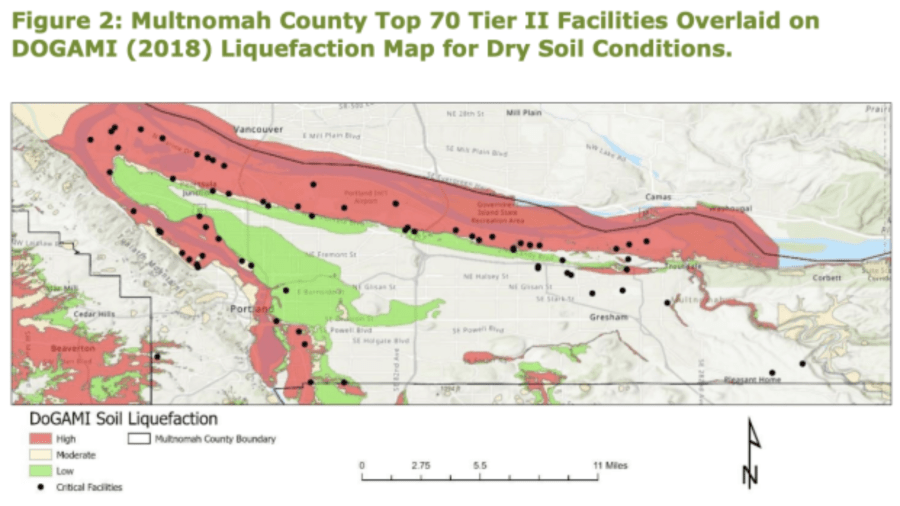Multnomah County urges action on threat of toxic gasses in Cascadia earthquake

PORTLAND, Ore. (KOIN) – Multnomah County commissioners are urging lawmakers to address the threat of deadly gasses being released in the event of a Cascadia Subduction Zone earthquake.
During a roundtable held Wednesday with state lawmakers, Multnomah County commissioners said addressing the threat is among their legislative priorities during the 2024 legislative session running from Feb. 5 to March 10.
Commissioner Jesse Beason asked lawmakers to respond to the county’s 2023 Hazardous Materials Report, prepared by Portland State University, which found that “in the event of a Cascadia Subduction Zone earthquake, toxic plumes from storage tanks could kill thousands of people and sicken tens of thousands.”
‘DRUNKY’, ‘URM0MM’: Every personalized license plate rejected by the Oregon DMV in 2023
Citing the report, the county says hazardous gasses could emerge from over 1,000 above-ground chemical storage tanks that were built in North and Northeast Portland before current seismic standards. The county says the storage tanks are on soil that would liquefy when the ground moves and would cause the tanks to rupture.
Additionally, the report found 70 toxic chemical facilities mostly located in soil zones that could liquefy.
Based on the scope of the study, researchers focused on 27 hazardous material facilities in Northwest and North Portland. Researchers found that 23 of these facilities were assumed to be vulnerable to earthquakes.

During the roundtable, Beason said addressing the threat “is a first step to prevent deaths.”
The report warns “The best-known threat of earthquake-induced hazardous material releases in Multnomah County is the Critical Energy Infrastructure (CEI) Hub located along the Willamette River. Estimates suggest that during a Cascadia Subduction Zone (CSZ) earthquake, the CEI Hub may release between 65 and 194 million gallons of petrochemicals.
Oregon State Police looking for Wasco County sign slicer
“Such a catastrophic release will threaten the health of the more than 45,000 people who live or work near the CEI Hub with exposure to toxic concentrations of evaporating petrochemicals and the impacts of fires that are likely to start during the earthquake. These threats would arrive at a time when public response operations will be limited and will face significant barriers, including widespread infrastructure damage,” the report continues.
The report relied on a 2018 Oregon Department of Geology and Mineral Industries regional impact analysis of magnitude 9 conditions. PSU notes this is an initial study and encourages further studies to guide mitigation efforts.
PSU adds that the scenarios in the report are one of many potential scenarios in terms of what facilities could have uncontrolled releases.
Report: Vancouver residents live shorter on average due to environmental factors
These warnings come as officials warn of a looming earthquake in the Cascadia Subduction Zone.
“Oregon lies at a convergent continental boundary where two tectonic plates are colliding,” the Oregon Shakeout website, operated by the Oregon Department of Emergency Management and other state and federal agencies, states. “The Cascadia Subduction Zone is actually a 600-mile long earthquake fault stretching from offshore northern California to southern British Columbia. This fault builds up stress for hundreds of years as the Juan de Fuca and North America Plates push against each other. Eventually, the two plates rip apart, creating some of the largest earthquakes and tsunamis on earth.”
The Oregon Office of Emergency Management says the state has the potential for a 9.0+ magnitude earthquake on the Cascadia Subduction Zone.
The office states “The Cascadia Subduction Zone has not produced an earthquake since 1700 and is building up pressure where the Juan de Fuca Plate is subsiding underneath the North American plate. Currently, scientists are predicting that there is about a 37% chance that a megathrust earthquake of 7.1+ magnitude in this fault zone will occur in the next 50 years. This event will be felt throughout the Pacific Northwest.”
For the latest news, weather, sports, and streaming video, head to KOIN.com.

